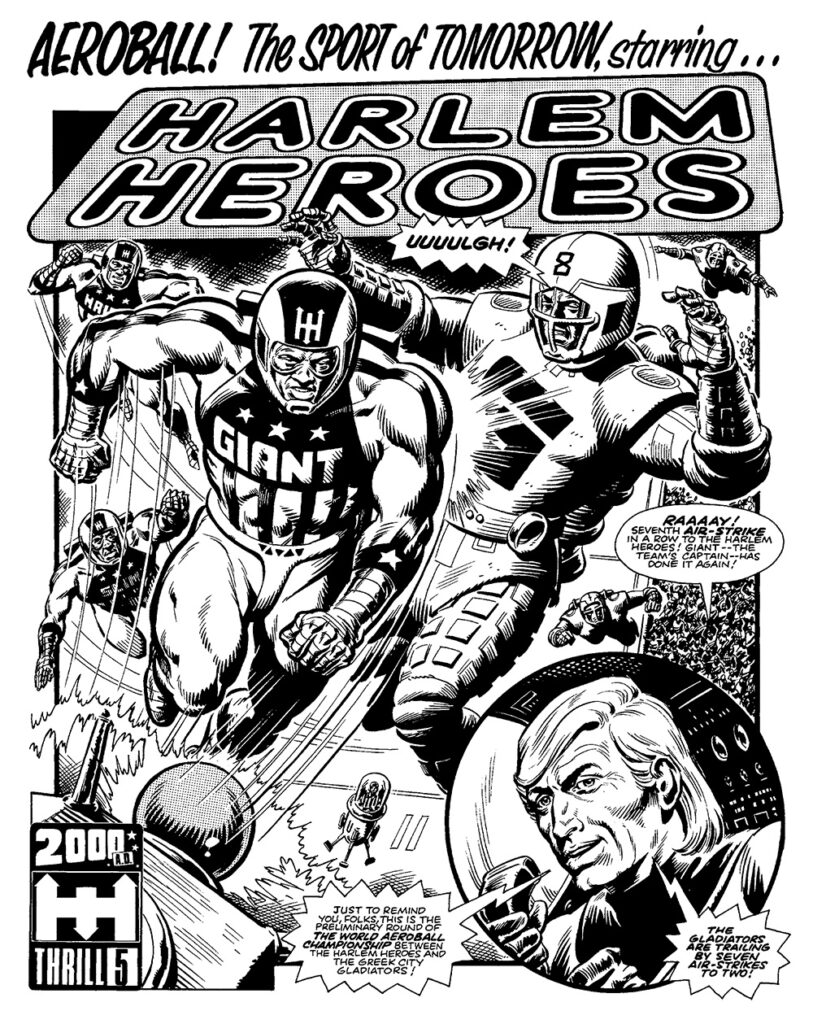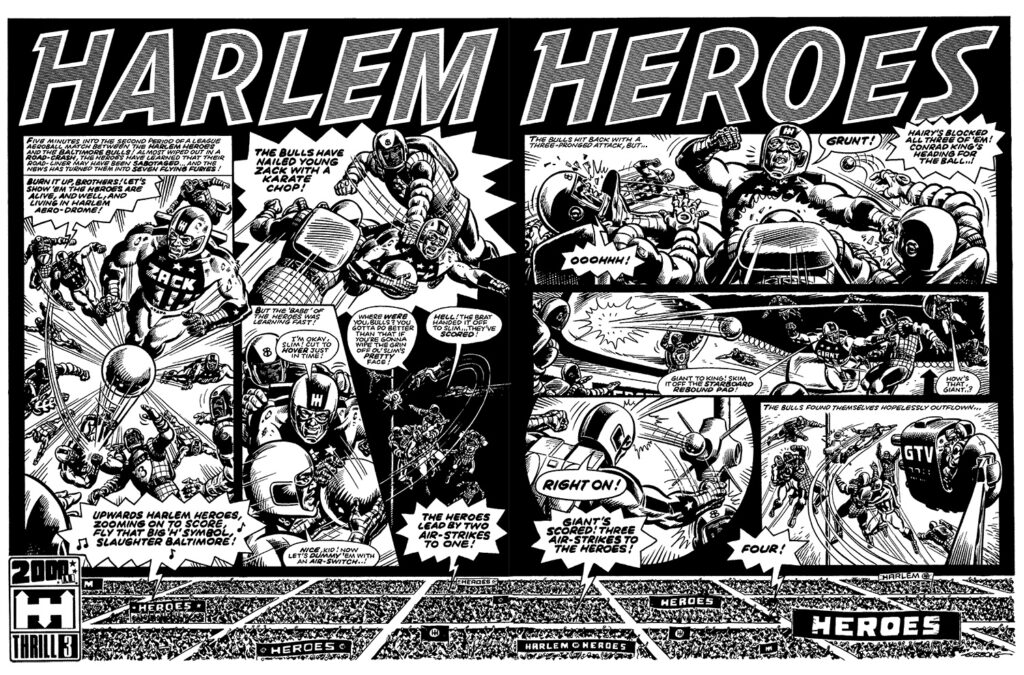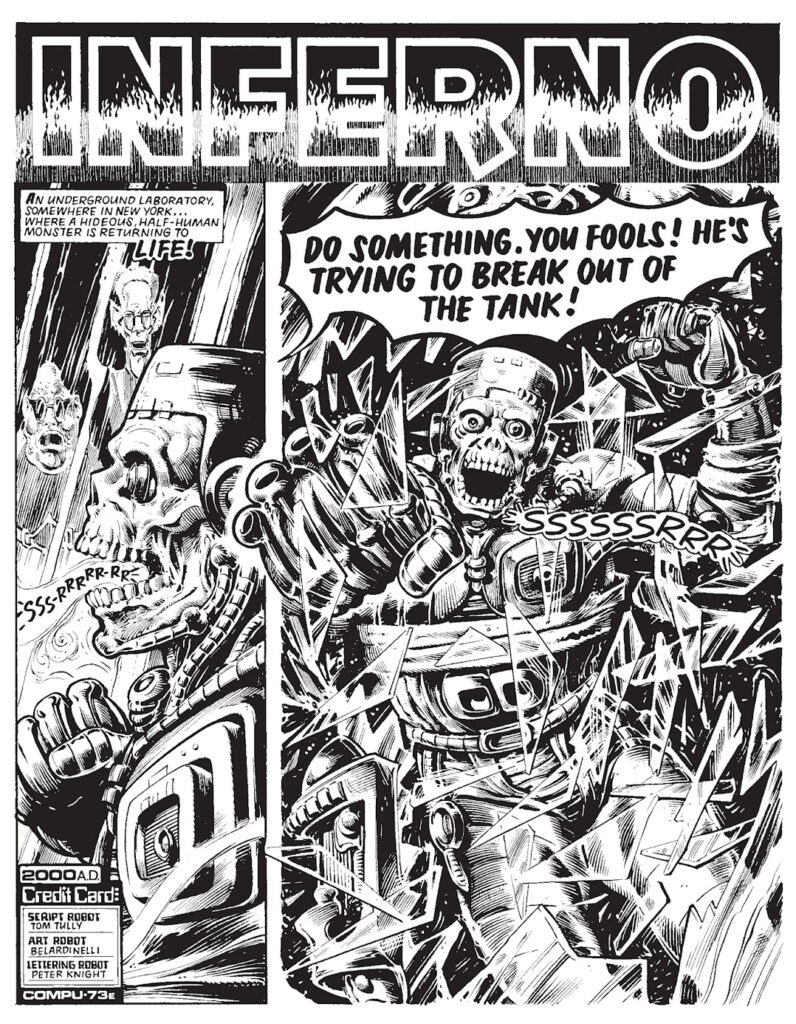Discover “The Sport of Tomorrow!” with 2000 AD Encyclopedia Supplemental #1
1st February 2022
It’s just two weeks until the first definitive encyclopedia of 2000 AD hits shelves! This stunning hardcover promises to give Earthlets chapter and verse on forty-five years of the Galaxy’s Greatest Comics.
Written by Scott Montgomery and with jaw-dropping illustrations by some of the world’s top artists alongside detailed profiles on the stories and characters from the pages of this legendary comic, from the luckless Aaron A. Aardvark of Judge Dredd to the weaponised (but very polite) undead crusader Zombo.
PRE-ORDER NOW >>
In the lead-up to publication, Scott takes a look at three fascinating Thrills and elaborates a bit more on their history, characters, and place in the 2000 AD pantheon. First up, it’s the stellar sports team from the dawn of 2000 AD – the HARLEM HEROES…

In March 2020 I was fortunate enough to be asked by Tharg (AKA editor Matt Smith) to compile the 2000 AD Encyclopedia. It was a daunting but exciting prospect. This mammoth project would start to be serialised in Judge Dredd Megazine by the following September’s 30th Anniversary Meg (no 428) – so I had to get cracking to avoid Mek-Quake’s wrath!
One of the many joys of assembling such a gargantuan tome – which is lovingly put together in one zarjaz, hardback mega-volume available on February 15th – was re-reading the Thrills that were there right from the very start.
Way back on 26th February 1977, the line-up for 2000 AD’s debut issue consisted of Flesh, M.A.C.H.1, Invasion!, Dan Dare and Harlem Heroes.
The latter series was a futuristic spin on a staple of 1970s boys’ comics – the sports strip. Intended, of course, as a homage to the legendary basketball team, the Harlem Globetrotters – founding editor Pat Mills was also inspired by the tough, then-contemporary movie Rollerball.
The Harlem Heroes, however, played Aeroball – a brutal mix of kung-fu, football, basketball and boxing; with the players, who could get seriously injured or even die during the game, whizzing around on jetpacks.
Writer Tom Tully had already scripted the likes of Football Family Robinson and Roy of the Rovers for publishers IPC, so he was a seasoned pro of the sports strip. Illustrating Tully’s work was a young, talented new artist called Dave Gibbons whose dynamic line art was hugely impressive. He would, quite rightly, go on to be a major force in comic art, not just in Britain but also in the United States.

In the year 2050, the Heroes are led by John ‘Giant’ Clay – who will eventually have a significant connection to the Judge Dredd universe – Ole Stoney Face himself famously debuted in Prog 2; held back from the premier issue to entice readers back the following week. In typical 2000 AD fashion, the main characters are all but wiped out in a tragic accident involving their team vehicle – but Giant and a few fellow survivors vow to come back and win the World Aeroball Championships in honour of their fallen teammates. However, their ‘accident’ was in fact, an act of treachery, someone wants them dead…
Here’s the Encyclopedia entry:
By the year 2050, the game of Aeroball has swept the world. It is football, boxing, kung-fu and basketball all rolled into one. Players roar through the air wearing jetpacks, fghting off opponents to put the gas-powered steel ball in the ‘score tank’.
One of the greatest teams is the Harlem Heroes. Led by John ‘Giant’ Clay these players are like no others in the exciting, thrill-packed sport of the future. They eschew the safety of protective body armour so that they can run rings around their rivals.
Tragedy strikes when a hover-liner crash kills all of the team apart from Giant, Slim, Hairy and Louis – although the latter is so badly injured he is left as a disembodied brain in a jar. Nonetheless, Louis galvanises the survivors into rebuilding the team in an attempt to win the world championship.
The squad is boosted by reserves, Chico and Sammy, veteran player Conrad King and a fiery youth, Zack Harper, who learnt Aeroball on the Harlem streets and Giant takes under his wing.
Ulysses Cord, the affluent head of Trans- World Networks, has just paid one hundred million dollars for the world tri-vision rights on aeroball. He becomes the Heroes’ self-appointed sponsor, much to the annoyance of Giant, who is wary of Cord’s interference. At one point the businessman suggests that the Heroes adopt a more brutal style of playing, like some of their opponents.
Things take a sinister turn when it becomes apparent that the ‘accident’ was nothing of the kind and a former teammate, Artie Gruber – disfigured and brain-damaged in an earlier match and mistakenly blaming Giant – is out to kill him and the others.
However, after yet more deaths at Gruber’s cybernetic hands – who escapes, his fate unknown – it soon becomes clear that a shadowy figure is controlling the deranged half-human. The Heroes eventually unmask the villain as Ulysses Cord, who wanted them dead as he believed their skills and good sportsmanship were turning Aeroball into a bloodless parlour game that no one would watch – not a good return on the millions he paid to televise Aeroball exclusively.
The Heroes – although only Giant, Slim and Zack are left alive – win the world title. With nothing else to achieve, what will they do now?
- Essential info:
- Self-contained serial in Progs 1-27
- Series created by: Pat Mills & Tom Tully (writers) and Dave Gibbons & Carlos Trigo (artists)
After 27 issues, although the Harlem Heroes’ story had apparently run its course, they would swiftly return in an even more violent follow-up – the ultra-violent Inferno – with Tully scripting once again and Massimo Belardinelli taking over on art (having also completed the final few episodes of the original series). Inferno’s ending is one of the most downbeat in early 2000 AD’s history.

Later, we learn Giant’s legacy. His grown-up son would become a Mega-City Judge – and a close friend of Judge Dredd. Judge Giant would, shockingly, die at the hands of Sov assassin Orlok. In a neat development; Dredd co-creator and writer John Wagner, would have Judge Giant father a secret, illegitimate son; who would in turn take on his father’s mantle. Cadet Giant would go on to become a fine Judge in his own right and, also like his father, earning the respect of Dredd himself and becoming a trusted confidante.
One curio in the Harlem Heroes saga is the so-called ‘re-boot’ which debuted in March 1990’s Prog 671. Many years in the future, a gang of convicts are so good at Aeroball that they are nicknamed the ‘Harlem Heroes’ by their fellow inmate and… er, that’s it. They become embroiled in an insidious government scheme to bring down the current regime. Framed for murder of the President and on the run, they must fight to clear their names. While it’s an average slice of action hokum, scripted by Michael Fleisher (and boasts some great art by Steve Dillon and Kevin Walker and others); there really is zero connection to the source material – apart from appropriating the title of one of the earliest thrills in 2000 AD’s canon. It’s best to forget this reboot/remake/footnote/whatever it is.
Instead, go back to the fantastic Tully and Gibbons’ original and settle down to enjoy a game of ‘Aeroball – the Sport of Tomorrow!’
The 2000 AD Encyclopedia is out on 15 February and will be available from all good book and comic stores, as well as online retailers and 2000 AD’s webshop and app.
